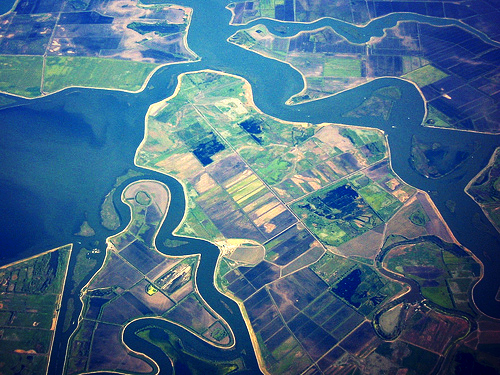Originally posted at Fox & Hounds Daily.
By Jerry Meral.
Fortunately, in this day of bitter partisan divides, there are some issues which can unite people across the political spectrum. Water reliability and ecological restoration can be two such issues.
California’s vibrant economy and strong employment growth are both reliant on a dependable water supply. An interruption or reduction in the supply of water to most of the state from the Sacramento-San Joaquin River Delta would cost the economy as much as $10 billion a year, and up to 40,000 jobs.
The Delta, where the Sacramento and San Joaquin Rivers join just south of Sacramento, provides nearly one-fifth of California’s water supply. It is more than 40 percent of the water supply for Silicon Valley, 100 percent for the industries of northern Contra Costa County, 25 to 80 percent of the water for much of the agricultural heartland of the San Joaquin Valley, and one-third of the water for urban Southern California.
There are two threats to the Delta water supply. Since most of the Delta islands are below sea level, breaks in island levees due to earthquakes or other causes may allow the ocean to rush in, making Delta water unusable.
An additional ongoing problem is how to export water from the Delta without harming native fish species, such as commercially vital salmon. The requirements of the state and federal endangered species acts severely restrict the amount of water that can be pumped from the Delta to protect listed species.
This has led to instability in water deliveries and has placed a hardship on downstream communities and agricultural users. The Bay Delta Conservation Plan (BDCP) seeks to stabilize Delta water deliveries, while restoring the Delta ecosystem.
It includes a proposed tunnel project connecting the Sacramento River (the source of most water in the Delta) with the state and federal water pumps in the south Delta near Tracy. It would provide secure and reliable water deliveries in the event that levee failure compromises water quality near the pumps. This also would help restore natural flow patterns in the Delta, protecting salmon and other fish species. The configuration of the south Delta system today is a dead end. Two out of three fish that get trapped there die. Other features of the plan will improve food production and rearing and migrating habitat for fish.
In addition to 11 fish species, BDCP covers 46 species dependent on terrestrial ecosystems. In fact, the BDCP would be the largest terrestrial natural community conservation plan in Northern California in terms of many important metrics: number of species, plan size, conservation amount, and funding. Historically, hundreds of thousands of acres of tidal marsh occurred in the Delta and Suisun Marsh. Over 95 percent of this has been lost. BDCP would restore nearly 30,000 acres (47 square miles) of tidal marsh in the Delta and Suisun Marsh, almost tripling the amount currently existing. This restoration would benefit a large number of native species that depend on these habitats such as resident and migratory waterfowl, shorebirds, river otters, kit fox, coyote, shrimp and other crustaceans, aquatic insects, fish, and native plants. BDCP would provide extensive areas of transitional uplands to ensure that tidal marsh can persist and “migrate” upslope in the face of expected sea level rise. Historically, tens of thousands of acres of riparian woodland and forest occurred in the Delta and Suisun Marsh. Over 95 percent of this has also been lost. BDCP would increase riparian woodland and forest in the Delta and Suisun Marsh by over 4,200 acres (over 6 square miles). Restored woodland would occur in large, interconnected blocks that would substantially expand habitat for many nesting birds, including migratory songbirds and raptors.
As President John F. Kennedy so aptly said at the groundbreaking for San Luis Reservoir, “In this project one part of your state has been willing to help another part because they realize that as this state does well, so does the United States.” (See the video of President Kennedy’s remarks).
Now is the time for business, labor, water districts and conservationists to come together to meet the economic and environmental co-equal goals for the Bay Delta.
The draft Bay Delta Conservation Plan will be released for public comment in December, and would be implemented beginning in 2016, once all necessary state and federal permits are obtained. For more information, see http://www.baydeltaconservationplan.com.
* * *
Dr. Jerry Meral is deputy secretary of the California Natural Resources Agency.





